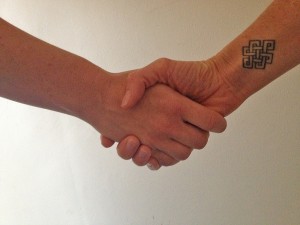I’ve been thinking a lot recently about what it means to be an effective advocate. In addition to being active in the Marfan community, I’ve also been involved (to a lesser extent) in autism communities. (I say communities because the organizations and their missions vary widely and I have yet to find an organization whose mission and activities I can fully support.) I’ve seen advocacy approached in a variety of ways among both diagnoses’ communities – some of which I think are more effective than others – and from that I’ve created some rules of advocacy.
The first rule is a long-standing philosophy, and that’s “nothing about us without us.” No decisions affecting whomever you’re advocating for should be made without the input of that community (typically referred to as self-advocates), inasmuch as that is possible (meaning people of that community exist to consult…some diseases may have a very short life expectancy). I hope I don’t have to explain all the reasons it’s important for self-advocates to have a say in how they’re talked about and what programs are developed for them!
The second rule of advocacy is to assume love. Start with the assumption that most people really do want to do the right thing, even if you don’t agree on what the right thing is. In a perfect world, what self advocates want and what parent advocates want would always line up exactly. But, parent advocates are often not affected with the condition themselves (i.e. – many autism parent advocates I know are not also autistic), and even if they are, their opinion may be different from their child’s. (I know what it’s like to have Marfan syndrome, but how J ultimately feels about having Marfan may completely differ from me.) Still, even with these differences, we can assume that most parents love and want what’s best for their children. That assumption makes…
Responding with patience easier. When you’re doing advocacy work of any kind, people are going to offend you. People are going to advocate for, do, or say things that you believe are wrong. You should absolutely speak up! The way in which you respond though will have an impact on how your message is received. For example, I may disagree with parents who refuse to allow their child the option to participate in the Marfan and related disorders community. But, I can understand that there are probably many reasons for their decision, including fear of the present or future, lack of understanding about how the Marfamily functions, lack of knowledge about potential benefits, or past bad experiences (either related to Marfan or not). I will have better luck at perhaps changing their minds if I take the time to get to know them and try to see where they’re coming from first. If I jump to a conclusion/assume my story is their story, or assert my position as the only possibility immediately, I’m liable to close doors.
I would also say it’s more effective to argue an idea rather than an individual. Public shaming usually puts people on the defensive, and that closes doors. Taking someone aside, meeting them where they’re at in their beliefs, and then bringing forward your argument has a greater chance of working. That doesn’t mean you agree with their beliefs, or ignore what it’s important to you, it just allows the other person to feel heard. And while you may not agree on one issue (such as the importance of a cure), you may see that you can move forward together to work on something else (like expanding acceptance in schools). That is still an advocacy win!
Lastly, know when to walk away. Changing people’s minds takes time. They may not be ready to hear what you have to say, or they may fundamentally disagree with you and that will never change. You can’t win over everyone.
Are there any rules you’d add to this list?



